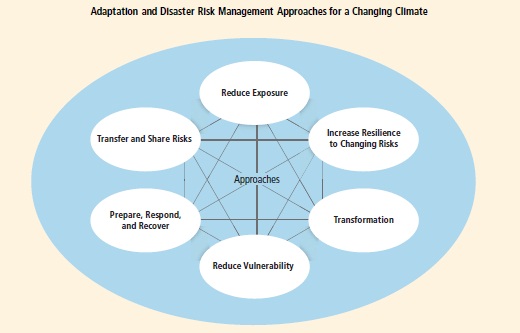It looks like you're using an Ad Blocker.
Please white-list or disable AboveTopSecret.com in your ad-blocking tool.
Thank you.
Some features of ATS will be disabled while you continue to use an ad-blocker.
IPCC Special Report : Managing the Risk of Extreme Events and Disasters to Advance Climate Change
page: 13
share:
I did not find this being discussed on ATS when I did a search for this document. This appears to just be a summary for policy makers, and the full
report will be available in Feb 2012.
Note: This is a pdf file. I have shown the first page of the file.
www.ipcc-wg2.gov...
Managing the Risks of Extreme Events and Disasters to Advance
Climate Change Adaptation
A Special Report of Working Group I and Working Group II
of the Intergovernmental Panel on Climate Change
Press Release pdf file
Presentation pdf file
I will comment more in depth after further study of this document.
Note: This is a pdf file. I have shown the first page of the file.
www.ipcc-wg2.gov...
Managing the Risks of Extreme Events and Disasters to Advance
Climate Change Adaptation
A Special Report of Working Group I and Working Group II
of the Intergovernmental Panel on Climate Change
A. CONTEXT
This Summary for Policymakers presents key findings from the Special Report on Managing the
Risks of Extreme Events and Disasters to Advance Climate Change Adaptation (SREX). The
SREX approaches the topic by assessing the scientific literature on issues that range from the
relationship between climate change and extreme weather and climate events (“climate
extremes”) to the implications of these events for society and sustainable development. The
assessment concerns the interaction of climatic, environmental, and human factors that can lead
to impacts and disasters, options for managing the risks posed by impacts and disasters, and the
important role that non-climatic factors play in determining impacts. Box SPM.1 defines
concepts central to the SREX.
[MOVE BOX SPM.1 IN CLOSE PROXIMITY]
The character and severity of impacts from climate extremes depend not only on the extremes
themselves but also on exposure and vulnerability. In this report, adverse impacts are considered
disasters when they produce widespread damage and cause severe alterations in the normal
functioning of communities or societies. Climate extremes, exposure, and vulnerability are
influenced by a wide range of factors, including anthropogenic climate change, natural climate
variability, and socioeconomic development (Figure SPM.1). Disaster risk management and
adaptation to climate change focus on reducing exposure and vulnerability and increasing
resilience to the potential adverse impacts of climate extremes, even though risks cannot fully be
eliminated (Figure SPM.2). Although mitigation of climate change is not the focus of this report,
adaptation and mitigation can complement each other and together can significantly reduce the
risks of climate change. [SYR AR4, 5.3]
This report integrates perspectives from several historically distinct research communities
studying climate science, climate impacts, adaptation to climate change, and disaster risk
management. Each community brings different viewpoints, vocabularies, approaches, and goals,
and all provide important insights into the status of the knowledge base and its gaps. Many of the
key assessment findings come from the interfaces among these communities. These interfaces
are also illustrated in Table SPM.1. To accurately convey the degree of certainty in key findings,
the report relies on the consistent use of calibrated uncertainty language, introduced in Box
SPM.2. The basis for substantive paragraphs in this Summary for Policymakers can be found in
the chapter sections specified in square brackets.
[INSERT FIGURE SPM.1 HERE:
Figure SPM.1: Illustration of the core concepts of SREX. The report assesses how exposure and
vulnerability to weather and climate events determine impacts and the likelihood of disasters
(disaster risk). It evaluates the influence of natural climate variability and anthropogenic climate
change on climate extremes and other weather and climate events that can contribute to disasters,
as well as the exposure and vulnerability of human society and natural ecosystems. It also
considers the role of development in trends in exposure and vulnerability, implications for
disaster risk, and interactions between disasters and development.
Press Release pdf file
Presentation pdf file
I will comment more in depth after further study of this document.
edit on 28-12-2011 by isyeye because: (no reason given)
Extreme and non-extreme weather or climate events affect vulnerability to future extreme
events, by modifying resilience, coping capacity, and adaptive capacity. [2.4.3] In particular,
the cumulative effects of disasters at local or sub-national levels can substantially affect
livelihood options and resources and the capacity of societies and communities to prepare for and
respond to future disasters. [2.2, 2.7]
A changing climate leads to changes in the frequency, intensity, spatial extent, duration,
and timing of extreme weather and climate events, and can result in unprecedented
extreme weather and climate events. Changes in extremes can be linked to changes in the
mean, variance or shape of probability distributions, or all of these (Figure SPM.3). Some
climate extremes (e.g., droughts) may be the result of an accumulation of weather or climate
events that are not extreme when considered independently. Many extreme weather and climate
events continue to be the result of natural climate variability. Natural variability will be an
important factor in shaping future extremes in addition to the effect of anthropogenic changes in
climate. [3.1]
[INSERT FIGURE SPM.3 HERE:
Figure SPM.3: The effect of changes in temperature distribution on extremes. Different changes
of temperature distributions between present and future climate and their effects on extreme
values of the distributions: (a) Effects of a simple shift of the entire distribution towards a
warmer climate; (b) effects of an increase in temperature variability with no shift of the mean; (c)
effects of an altered shape of the distribution, in this example a change in asymmetry towards the
hotter part of the distribution. [Figure 1-2, 1.2.2] – LANDSCAPE VERSION IN DRAFT]
B. OBSERVATIONS OF EXPOSURE, VULNERABILITY,
CLIMATE EXTREMES, IMPACTS, AND DISASTER LOSSES
The impacts of climate extremes and the potential for disasters result from the climate extremes
themselves and from the exposure and vulnerability of human and natural systems. Observed
changes in climate extremes reflect the influence of anthropogenic climate change in addition to
natural climate variability, with changes in exposure and vulnerability influenced by both
climatic and non-climatic factors.
EXPOSURE AND VULNERABILITY
Exposure and vulnerability are dynamic, varying across temporal and spatial scales, and
depend on economic, social, geographic, demographic, cultural, institutional, governance,
and environmental factors (high confidence). [2.2, 2.3, 2.5] Individuals and communities are
differentially exposed and vulnerable based on inequalities expressed through levels of wealth
and education, disability, and health status, as well as gender, age, class, and other social and
cultural characteristics. [2.5]
Settlement patterns, urbanization, and changes in socioeconomic conditions have all
influenced observed trends in exposure and vulnerability to climate extremes (high
confidence). [4.2, 4.3.5] For example, coastal settlements, including in small islands and megadeltas, and mountain settlements are exposed and vulnerable to climate extremes in both
developed and developing countries, but with differences among regions and countries. [4.3.5,
4.4.3, 4.4.6, 4.4.9, 4.4.10] Rapid urbanization and the growth of megacities, especially in
developing countries, have led to the emergence of highly vulnerable urban communities,
particularly through informal settlements and inadequate land management (high agreement,
robust evidence). [5.5.1] See also case studies 9.2.8 and 9.2.9. Vulnerable populations also
include refugees, internally displaced people, and those living in marginal areas. [4.2, 4.3.5]
CLIMATE EXTREMES AND IMPACTS
There is evidence from observations gathered since 1950 of change in some extremes.
Confidence in observed changes in extremes depends on the quality and quantity of data
and the availability of studies analyzing these data, which vary across regions and for
different extremes. Assigning “low confidence” in observed changes of a specific extreme
on regional or global scales neither implies nor excludes the possibility of changes in this
extreme. Extreme events are rare which means there are few data available to make assessments
regarding changes in their frequency or intensity. The more rare the event the more difficult it is
to identify long-term changes. [3.2.1] Global-scale trends in a specific extreme may be either
more reliable (e.g., for temperature extremes) or less reliable (e.g., for droughts) than some
regional-scale trends, depending on the geographical uniformity of the trends in the specific
extreme. The following paragraphs provide further details for specific climate extremes from
observations since 1950. [3.1.5, 3.2.1]
It is very likely that there has been an overall decrease in the number of cold days and nights3,
and an overall increase in the number of warm days and nights3, on the global scale, i.e., for most land areas with sufficient data. It is likely that these changes have also occurred at the continental scale in North America, Europe, and Australia. There is medium confidence of a warming trend
in daily temperature extremes in much of Asia. Confidence in observed trends in daily
temperature extremes in Africa and South America generally varies from low to medium
depending on the region. In many (but not all) regions over the globe with sufficient data there is
medium confidence that the length or number of warm spells, or heat waves3, has increased.
[3.3.1, Table 3.2]
[INSERT FOOTNOTE 3: See SREX glossary for definition of these terms; cold days / cold
nights, warm days / warm nights, and warm spell – heat wave.]
There have been statistically significant trends in the number of heavy precipitation events in
some regions. It is likely that more of these regions have experienced increases than decreases,
although there are strong regional and subregional variations in these trends. [3.3.2]
There is low confidence in any observed long-term (i.e., 40 years or more) increases in tropical
cyclone activity (i.e., intensity, frequency, duration), after accounting for past changes in
observing capabilities. It is likely that there has been a poleward shift in the main Northern and
Southern Hemisphere extra-tropical storm tracks. There is low confidence in observed trends in
small spatial-scale phenomena such as tornadoes and hail because of data inhomogeneities and inadequacies in monitoring systems. [3.3.2, 3.3.3, 3.4.4, 3.4.5]
edit on 28-12-2011 by isyeye because: (no reason given)
reply to post by isyeye
Explanation: S&F!
Uhmmm?
So basically bad stuff WILL happen ... eventually!
And TPTB have no clue!
If TPTB can NOT garantee full control over the climate then why should [y]our TAX $$$ pay for something that wont work?
Personal Disclosure: This is about $$$ and Power ... do TPTB have full control or not? ... and if not, then they don't deserve to be paid any of [y]our Tax to fix something that can't be fixed!
It's a SCAM!
Explanation: S&F!
Uhmmm?
Disaster risk management and adaptation to climate change focus on reducing exposure and vulnerability and increasing resilience to the potential adverse impacts of climate extremes, even though risks cannot fully be eliminated.
So basically bad stuff WILL happen ... eventually!
Extreme events are rare which means there are few data available to make assessments
regarding changes in their frequency or intensity.
And TPTB have no clue!
If TPTB can NOT garantee full control over the climate then why should [y]our TAX $$$ pay for something that wont work?
Personal Disclosure: This is about $$$ and Power ... do TPTB have full control or not? ... and if not, then they don't deserve to be paid any of [y]our Tax to fix something that can't be fixed!
It's a SCAM!
I noticed something a little interesting on page 20 of the document.
Take a close look at the symbol that they are using.

The symbol of Thelema, or the symbol for "The Great Work"

It is also a symbol of light or serpents used in early Christian and pre-Christian mythology.

It could be just a coincidence.....but,
hmmm........I think I smell a conspiracy.
Take a close look at the symbol that they are using.

The symbol of Thelema, or the symbol for "The Great Work"

It is also a symbol of light or serpents used in early Christian and pre-Christian mythology.

It could be just a coincidence.....but,
hmmm........I think I smell a conspiracy.
new topics
-
A Warning to America: 25 Ways the US is Being Destroyed
New World Order: 2 hours ago -
President BIDEN's FBI Raided Donald Trump's Florida Home for OBAMA-NORTH KOREA Documents.
Political Conspiracies: 8 hours ago -
Maestro Benedetto
Literature: 10 hours ago -
Is AI Better Than the Hollywood Elite?
Movies: 10 hours ago
top topics
-
President BIDEN's FBI Raided Donald Trump's Florida Home for OBAMA-NORTH KOREA Documents.
Political Conspiracies: 8 hours ago, 28 flags -
Gaza Terrorists Attack US Humanitarian Pier During Construction
Middle East Issues: 15 hours ago, 8 flags -
Massachusetts Drag Queen Leads Young Kids in Free Palestine Chant
Social Issues and Civil Unrest: 17 hours ago, 7 flags -
Las Vegas UFO Spotting Teen Traumatized by Demon Creature in Backyard
Aliens and UFOs: 13 hours ago, 6 flags -
A Warning to America: 25 Ways the US is Being Destroyed
New World Order: 2 hours ago, 6 flags -
Meadows, Giuliani Among 11 Indicted in Arizona in Latest 2020 Election Subversion Case
Mainstream News: 16 hours ago, 5 flags -
2024 Pigeon Forge Rod Run - On the Strip (Video made for you)
Automotive Discussion: 14 hours ago, 4 flags -
Is AI Better Than the Hollywood Elite?
Movies: 10 hours ago, 3 flags -
The functionality of boldening and italics is clunky and no post char limit warning?
ATS Freshman's Forum: 16 hours ago, 1 flags -
Maestro Benedetto
Literature: 10 hours ago, 1 flags
3
